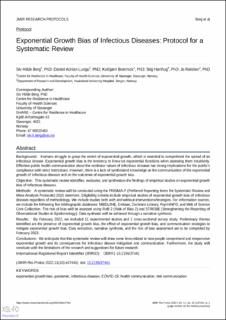| dc.contributor.author | Berg, Siv Hilde | |
| dc.contributor.author | Lungu, Daniel Adrian | |
| dc.contributor.author | Brønnick, Kolbjørn Kallesten | |
| dc.contributor.author | Harthug, Stig | |
| dc.contributor.author | Røislien, Jo | |
| dc.date.accessioned | 2022-12-20T12:42:54Z | |
| dc.date.available | 2022-12-20T12:42:54Z | |
| dc.date.created | 2022-11-06T11:49:03Z | |
| dc.date.issued | 2022-10 | |
| dc.identifier.citation | Berg, S.H., Lungu, D.A., Brønnick, K., Harthug, S., Røislien, J. (2022) Exponential Growth Bias of Infectious Diseases: Protocol for a Systematic Review. JMIR Research Protocols, 11 (10), e37441 | en_US |
| dc.identifier.issn | 1929-0748 | |
| dc.identifier.uri | https://hdl.handle.net/11250/3038834 | |
| dc.description.abstract | Background: Humans struggle to grasp the extent of exponential growth, which is essential to comprehend the spread of an infectious disease. Exponential growth bias is the tendency to linearize exponential functions when assessing them intuitively. Effective public health communication about the nonlinear nature of infectious diseases has strong implications for the public’s compliance with strict restrictions. However, there is a lack of synthesized knowledge on the communication of the exponential growth of infectious diseases and on the outcomes of exponential growth bias. Objective: This systematic review identifies, evaluates, and synthesizes the findings of empirical studies on exponential growth bias of infectious diseases. Methods: A systematic review will be conducted using the PRISMA-P (Preferred Reporting Items for Systematic Review and Meta-Analysis Protocols) 2015 statement. Eligibility criteria include empirical studies of exponential growth bias of infectious diseases regardless of methodology. We include studies both with and without interventions/strategies. For information sources, we include the following five bibliographic databases: MEDLINE, Embase, Cochrane Library, PsychINFO, and Web of Science Core Collection. The risk of bias will be assessed using RoB 2 (Risk of Bias 2) and STROBE (Strengthening the Reporting of Observational Studies in Epidemiology). Data synthesis will be achieved through a narrative synthesis. Results: By February 2022, we included 11 experimental studies and 1 cross-sectional survey study. Preliminary themes identified are the presence of exponential growth bias, the effect of exponential growth bias, and communication strategies to mitigate exponential growth bias. Data extraction, narrative synthesis, and the risk of bias assessment are to be completed by February 2023. Conclusions: We anticipate that this systematic review will draw some lines related to how people comprehend and misperceive exponential growth and its consequences for infectious disease mitigation and communication. Furthermore, the study will conclude with the limitations of the research and suggestions for future research. | en_US |
| dc.language.iso | eng | en_US |
| dc.publisher | JMIR Publications | en_US |
| dc.relation.uri | https://www.researchprotocols.org/2022/10/e37441/ | |
| dc.rights | Navngivelse 4.0 Internasjonal | * |
| dc.rights.uri | http://creativecommons.org/licenses/by/4.0/deed.no | * |
| dc.subject | smittsom sykdom | en_US |
| dc.subject | smitte | en_US |
| dc.subject | folkehelse | en_US |
| dc.subject | systematic review | en_US |
| dc.subject | epidemiologi | en_US |
| dc.subject | pandemi | en_US |
| dc.subject | COVID-19 | en_US |
| dc.subject | kommunikasjon | en_US |
| dc.title | Exponential Growth Bias of Infectious Diseases: Protocol for a Systematic Review | en_US |
| dc.type | Peer reviewed | en_US |
| dc.type | Journal article | en_US |
| dc.description.version | publishedVersion | en_US |
| dc.rights.holder | ©Siv Hilde Berg, Daniel Adrian Lungu, Kolbjørn Brønnick, Stig Harthug, Jo Røislien. | en_US |
| dc.subject.nsi | VDP::Medisinske Fag: 700::Klinisk medisinske fag: 750::Infeksjonsmedisin: 776 | en_US |
| dc.source.pagenumber | 6 | en_US |
| dc.source.volume | 11 | en_US |
| dc.source.journal | JMIR Research Protocols | en_US |
| dc.source.issue | 10 | en_US |
| dc.identifier.doi | 10.2196/37441 | |
| dc.identifier.cristin | 2069601 | |
| dc.relation.project | SHARE - Centre for Resilience in Healthcare: 5091 | en_US |
| dc.source.articlenumber | e37441 | en_US |
| cristin.ispublished | true | |
| cristin.fulltext | original | |
| cristin.qualitycode | 1 | |

